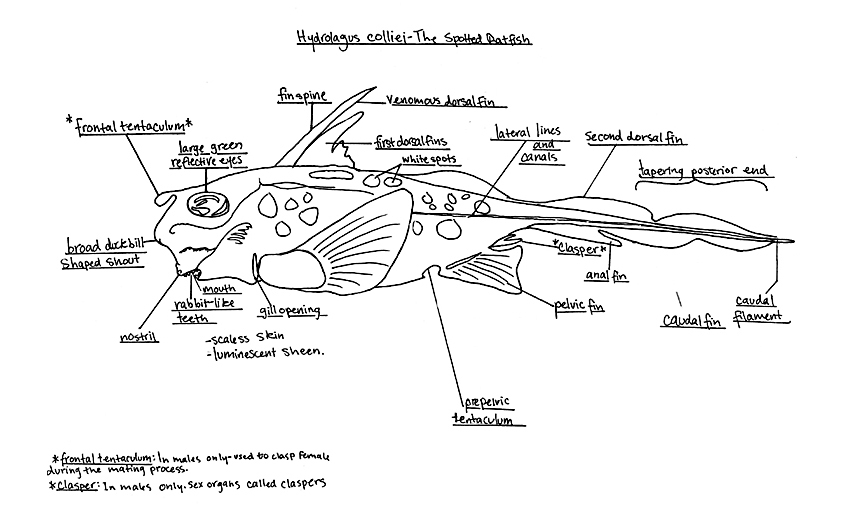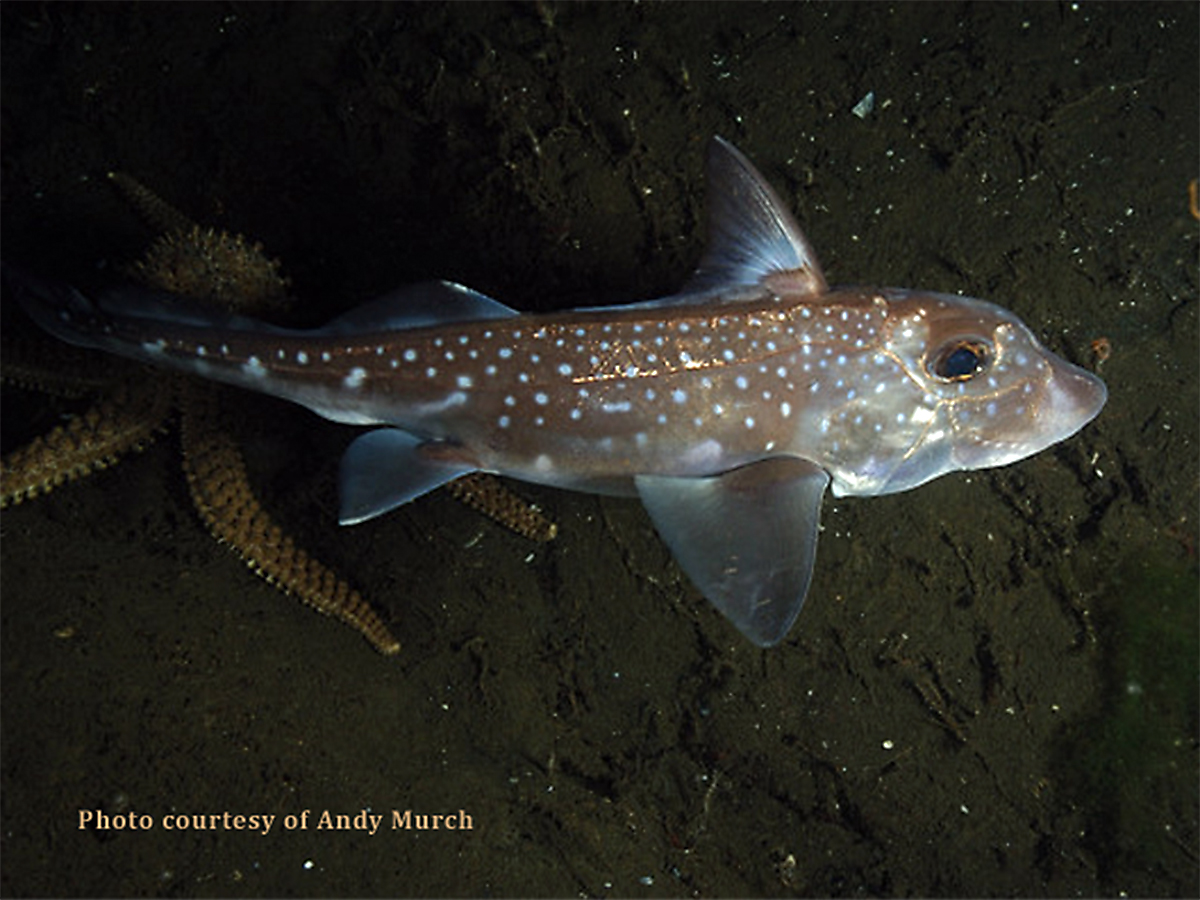Authors: Alberta Trelawny and Dakoda McGregor
Photo courtesy of Andy Murch
Common Name: Spotted Ratfish
Scientific Name: Hydrolagus colliei
Size range: females are up to 38inches (1m) in length while males are smaller
Identifying features : The spotted ratfish is a cartilaginous shark relative. It has many distinctive features and is in the Chimaera family. It is said to look like a rabbit and its scientific name: Hydrolagus colliei, literally translates to “water hare.” H. colliei has plate-like permanent teeth and a large, bulky, snout-like snub nose.

Illustration by Alberta Trelawny

The spotted ratfish’s body tapers towards its posterior end and composes about half of its length. The spotted ratfish has a large, sharp and venomous dorsal fin that can inflict a painful wound; and a long, leaf-like and delicate undulating fin follows the dorsal fin. The spotted ratfish also has two pectoral fins which extend straight out from its body, similar to airplane wings. One of the H. colliei’s most distinctive feature is it smooth, scale-less and iridescent skin. Its colouring can range from silvery to a golden green usually with a darker brown background that reflects light; the fish is also usually covered in white, opalescent spots which helps add to its distinctive luster. Another particular feature are the spotted ratfish’s large eyes; they are often green in colour and reflect light, much like those of a cat.
Habitat: The ratfish is usually found from the surface to as deep as 1000m. They are found along the coast of the Pacific Ocean from Alaska to Baja California. A great place to see the spotted ratfish locally while diving is just off of Ogden point, Victoria, British Columbia. When food in the deeper waters becomes scarce the H. colliei will often move to shallower waters, hanging near the ocean floor.
Prey : The Ratfish enjoys a diet of crustaceans, marine worms, small fish and mollusks. It is able to grind the shells with its plate-like teeth. The spotted ratfish is also a chronicled cannibal, often eating their own egg cases as well as other ratfishes.
Predators: Marine species who feed on the ratfish include different types of sharks such as the six gill shark, seven gill sharks, tope sharks, the spiny dogfish, and big carnivorous fish such as the giant sea bass, ling cod, rock fish, Pacific Halibut, and other marine mammals (such as seal, orcas, porpoises etc.). Humans do not consume the ratfish as they are unpalatable. It can also inflict a painful wound with its venomous dorsal fin and may also give a painful bite.
Life Cycle: The Ratfish begins its reproduction cycle during the autumn/spring seasons by conducting complicated courtship patterns during the mating season; both sex’s complete distinct manoeuvers and the males undergo extensive color changes. The females begin to expel eggs in pairs; they birth these eggs into muddy areas every 10-14 days and their fertile period will last several months. The female ratfishes labor can last anywhere between 18-30 hours. The eggs then hang freely from their mother attached by a thin filament. They hang attached for 4-6 days until they are planted in the ground. The eggs begin to hatch around a year later, which means the baby fish goes through a long gestation period and is born relatively matured. The young usually appear from the case at approximately 5.5 inches and grow about 11.8 inches in their first year.
References:
Barnett, L.A.K, R.L. Earley, D.A. Ebert and G.M. Cailliet. 2009. Maturity, fecundity, and reproductive cycle of the spotted ratfish, Hydrolagus colliei. Retrieved on May 4th 2012 from http://venus.uvic.ca/tag/spotted-ratfish/
Bester, C. January 2010. Spotted Ratfish, Ichthyology-Florida Museum of Natural History, Retrieved May 3rd 2011. From: http://www.flmnh.ufl.edu/fish/Gallery/Descript/SpottedRatfish/SpottedRatfish.html
Boyd, S. 2009. Spotted Ratfish-Hydrolagus Colliei. Emerald Sea Photography. Retrieved on May 4th 2012 from http://www.boydski.com/diving/photos/ratfish.htm
Clemens, W.A. Wilby, G. V. (1973) Pacific fishes of Canada, Ottawa,
Ont, Canada. Fisheries Research Board of Canada.
Murch, A. SPOTTED RATFISH. (n.d) Retrieved: May 4th 2012 from: http://www.elasmodiver.com/spotted_ratfish.htm
Lamb, A. and Edgell, P. (1986) Coastal fishes of the Pacific
Northwest. Madeira Park, BC, Canada. Harbour Publishing.
Oceanario de Lisboa, S.A. (n.d) SPOTTED RATFISH (HYDRLAGUS COLLIEI)-Sharks, Rays and Chimaeras. Retrieved on May 4th 2012 from http://www.oceanario.pt/cms/882
Oregon Coast Aquarium, (n.d) Retrieved on May 4th 2010 from http://aquarium.org/exhibits/coastal-waters/animals/spotted-ratfish
